Nov 21, 2010
October Spot Check - Colorado
Dr. Richard Keen, Coal Creek Canyon co-op observer
October Spot Check - Colorado
For the past four months I’ve posted a “spot check” comparing NCDC’s monthly analyzed temperature departure maps with actual departures observed a two Colorado stations, Coal Creek Canyon and Denver. Here’s October’s update.
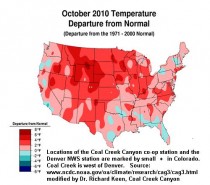
First, the map (with the station locations annotated) shows a 4-degree plus anomaly over northeast Colorado. However, the two stations - Coal Creek Canyon and Denver - logged departures from the 1971-2000 normal of 1.4 and 4.3 degrees, respectively. The large difference between the two anomalies likely reflects the absence of strong inversions that usually keep Denver cooler. The table compares the observed and analyzed departures over the five months for the two stations, and the story remains the same - NCDC’s analyses continue to run almost two degrees warmer than the actual station data.
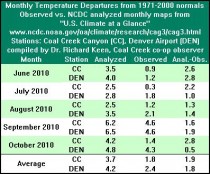
Read more here.
Nov 19, 2010
Global Warming could cool down temperatures in winter (UPDATED)
Press Release by the Potsdam Institute for Climate Impact Research (PIK)
Article: Petoukhov, V., and V. A. Semenov (2010), A link between reduced Barents-Kara sea ice and cold winter extremes over northern continents, J. Geophys. Res., 115, D21111[doi:10.1029/2009JD013568]
Press Release. Here is an excerpt from the release:
The overall warming of the earth’s northern half could result in cold winters. The shrinking of sea-ice in the eastern Arctic causes some regional heating of the lower levels of air - which may lead to strong anomalies in atmospheric airstreams, triggering an overall cooling of the northern continents, a study recently published in the Journal of Geophysical Research shows. “These anomalies could triple the probability of cold winter extremes in Europe and northern Asia,” says Vladimir Petoukhov, lead author of the study and climate scientist at the Potsdam Institute for Climate Impact Research. “Recent severe winters like last year’s or the one of 2005-06 do not conflict with the global warming picture, but rather supplement it.”
Here is the surface temperature pattern in 2009/10:
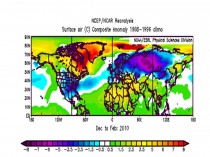
Winter 2009/10. Enlarged here.
The researchers base their assumptions on simulations with an elaborate computer model of general circulation, ECHAM5, focusing on the Barents-Kara Sea north of Norway and Russia where a drastic reduction of ice was observed in the cold European winter of 2005-06. Those surfaces of the sea lacking the ice cover lose a lot of warmth to the normally cold and windy arctic atmosphere. What the researchers did was to feed the computer with data, gradually reducing the sea ice cover in the eastern Arctic from 100 percent to 1 percent in order to analyse the relative sensitivity of wintertime atmospheric circulation.
“Our simulations reveal a rather pronounced nonlinear response of air temperatures and winds to the changes of sea-ice cover,” Petoukhov, a physicist, says. “It ranges from warming to cooling to warming again, as sea ice decreases.” An abrupt transition between different regimes of the atmospheric circulation in the sub-polar and polar regions may be very likely. Warming of the air over the Barents-Kara Sea seems to bring cold winter winds to Europe. “This is not what one would expect,” Petoukhov says.
“Whoever thinks that the shrinking of some far away sea-ice won’t bother him could be wrong. There are complex teleconnections in the climate system, and in the Barents-Kara Sea we might have discovered a powerful feedback mechanism.”
Other approaches to the issue of cold winters and global warming referring to reduced sun activity or most recently the gulf stream “tend to exaggerate the effects,” Petoukhov says. The correlation between these phenomena and cold winters is relatively weak, compared to the new findings referring to the processes in the Barents-Kara Sea. Petoukhov also points out that during the cold winter of 2005-06 with temperatures of ten degrees below the normal level in Siberia, no anomalies in the North Atlantic Oscillation have been observed.
Icecap Note: The arctic oscillation which corresponds very well with Siberia temperatures was profoundly negative in 2005/06 (with a brief exception in January, much like in 2009/10) thanks to a strong stratospheric warming event (anomalies 65-90 N for the 2005/06 winter with depiction of AO below). Note the dominance of this warming and of the negative AO that winter as was the case in 2009/10.
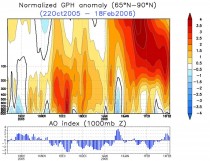
See enlarged here.
The AO correlation with temperatures shows a very cold Siberia.
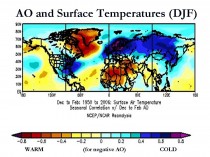
See enlarged here.
The study says the NAO was not supporting the cold. This was true in January (again like the AO), but the NAO was negative in November, December, February and March. See NOAA table column 3 here.
Petoukhov’s study is not about tomorrow’s weather forecast but about longtime probabilities of climate change. “I suppose nobody knows,” he says, “how harsh this year’s winter will be.”
Icecap Note: This is nonsense as the last three winters (and summers) using the various natural oscillations including PDO, AMO, ENSO, solar, volcanism and QBO, we have had excellent success in predicting many months in advance the observed patterns (surface temperatures and jet stream) we experienced globally. No GHG or so called “trends” were considered. We have for many years, using multivariate statistical relationships beaten the climate model and community consensus forecasts. PDF here.
See also Watts Up with That comments by Anthony and Ryan Maue here.
Nov 18, 2010
Climategate: One Year and Sixty House Seats Later
By Marc Sheppard, The American Thinker
It’s been one year to the day since hero or heroes still unnamed and unrewarded bestowed upon the world a virtual dossier, the contents of which should have ended the anthropogenic global warming (AGW) debate abruptly and evermore. Remarkably, it didn’t. Despite the revelations exposed in the now public climate huckster’s handbook, one year later the specter of governance and wealth redistribution both national and international based largely, if not solely, on pseudo-scientific hocus-pocus persists.
By all measures, last year’s U.N. climate summit in Copenhagen was an embarrassing flop for those who again tried to sell an international progressive fund reallocation scheme as the “last chance to save the planet” from runaway climate change. But with Cancun’s “last chance to save the planet” climate talks just around the corner, the media is working overtime to explain away previous failures as anything other than the product of bad policy toward unproven hazards that they indeed were.
On Monday, The Washington Post ran a piece about an Oxford University’s Reuters Institute study on who attended and how countries covered last year’s U.N. summit. But the paper’s emphasis was somewhat different and clearly divulged in its headline—Coverage of climate summit called short on science. Yet what truly boggles the mind is their assessment of that which we celebrate today: Much coverage from Copenhagen instead focused on hacked e-mails from a British university that some skeptics took as evidence of efforts by scientists to ignore dissenting views. The scientists involved have since been cleared of wrongdoing.
Ignore dissenting views? How about conspiring to block - not ignore—the publication of rival scientific evidence? Or the Nixonian plots the communiqués disclosed, including conspirators discussing deleting emails and other documents in order to prevent disclosure of information subject to Freedom of Information Laws? Or how access might be prevented to data, source code, and algorithms in an attempt to prevent external evaluation of their conclusions?
Not to mention their arrogant mockery of the peer review process atop a widespread complicity in and acceptance of hiding, manipulating, inventing and otherwise misrepresenting data in a clear effort to exaggerate the existence, causation, precedence and threat of global warming. What’s more, the fact that many of the conspirators were editors, lead authors, and contributors to the U.N’s Intergovernmental Panel on Climate Change (IPCC) and World Meteorological Organization (WMO) reports on which international climate policy is made put all such reports and policies to question.
Indeed, the documents, source-code, data and e-mails contained in the folder purportedly “hacked” from Britain’s University of East Anglia (UEA) Climate Research Unit (CRU) and first uploaded to a Russian FTP server in the wee hours of November 17, 2009—and announced that evening as a comment at Air Vent—revealed a widespread pattern of scientific misconduct amongst the very climate researchers on whose “science” the entire AGW theory and all consequent policy is based.
With trillions of dollars at stake, Climategate, as it was dubbed days later, was and is about potentially astronomical criminal wrongdoing, not petty school-yard rivalries. And as to those involved being “cleared of wrongdoing,” let’s consider both the tribunals and their actual pronouncements.
On With the Showcase Investigations
Last November was not a good month for climate alarmists, particularly the two primary Climategate conspirators, CRU chief Phil “Hide the Decline” Jones and Mike “Nature Trick” Mann. As the new-media-led understanding of the Climategate folder’s incriminating contents took wider purchase, with it did the cries for formal investigations, as the evidence of climate fraud appeared both devastating and incontrovertible. On December 1st, against the backdrop of business pending in Copenhagen, the U.K. House of Commons Science and Technology Committee sent a letter of intent and preliminary questionnaire to the UEA. The university’s response that it had commissioned its own “independent inquiry” under the auspices of Sir Muir Russell failed to dissuade the Committee’s decision to proceed with its own inquiry.
As the Russell investigation was to focus primarily on policy, the UEA later asked Ronald (Lord) Oxburgh to lead another “independent” team to investigate the scientific methodology of CRU. As if by design, that action allowed many facets of each investigation to be ignored by one while fingers bore down on the other. The Russell report stated that although they didn’t actually examine the science—such would be Oxburgh’s job—the science was nonetheless correct. Meanwhile, Lord Oxburgh specifically stated that his inquiry, although named the Science Appraisal Panel, did not look at the science. Oh, and CRU’s was just fine.
By August’s end, the final reports were in from all three “formal” investigations into CRU: The House of Commons Science and Technology Committee [PDF], The Oxburgh Science Appraisal Panel [PDF] and the Independent Climate Change Emails Review under Sir Muir Russell [PDF].
All three examinations took place within the country of physical jurisdiction, Great Britain, and none disappointed those of us anticipating whitewash. Simply stated, all parties were cleared of all wrongdoing other than perhaps sloppy journaling and sophomoric note-passing and all suspensions were lifted. As Andrew Montford summarized in his report, The Climategate Inquiries:
[T] here can be little doubt that none of [the inquiries] have performed their work in a way that is likely to restore confidence in the work of CRU. None has managed to be objective and comprehensive. None has shown a serious concern for the truth. The best of them - the House of Commons inquiry - was cursory and appeared to exonerate the scientists with little evidence to justify such a conclusion. The Oxburgh and Russell inquiries were worse. But an investigation was also undertaken by a Pennsylvania State University Inquiry Committee into the specific actions of the institution’s employee—Dr. Michael Mann. Based in the U.S., the Penn State inquiry offered perhaps the best hope of impartiality. After all, not only was a faculty member implicated at the deepest levels of the misconduct (See Understanding Climategate’s Hidden Decline), but also in the attempt to destroy evidence.
Unfortunately, it was Mann’s fellow Penn professors tasked with investigating him. According to the official report [PDF], following an interview with Mann during which he simply denied all particulars of misconduct against him, Inquiry Committee member Dr. Henry C. Foley “conveyed via email an additional request of Dr. Mann, who was asked to produce all emails related to the fourth IPCC report (AR4), the same emails that Dr. Phil Jones had suggested that he delete.”
So rather than demand a date-stamped e-mail dump from the University’s IT sector (the emails likely reside on their primary server or in some backup format and remain, in fact, the university’s property), the panel requested that the subject of their investigation make the decision which emails were relevant to their investigation. And three days later, he “provided a zip-archive of these emails and an explanation of their content.”
In other words—Michael Mann was allowed to cherry-pick not only data, but also the emails to be presented as evidence that he did so. Crazier still— one of the charges Mann faced was that he had deleted incriminating emails.
Given the hilarity of its methods, scant shock was elicited by the Investigatory Committee’s unanimous determination that “Dr. Michael E. Mann did not engage in, nor did he participate in, directly or indirectly, any actions that seriously deviated from accepted practices within the academic community for proposing, conducting, or reporting research, or other scholarly activities.”
Mann wasted no time declaring himself “exonerated” and the MSM proved equally efficient in its blathering concurrence.
Read how WaPo Leads the MSM Charge to Support Suppression and how the 2010 elections may change what comes next in the full article here.
Nov 17, 2010
November 20, 2009: The Day “Global Warming” Ended
By Alan Caruba
November 20, 2009 is an important date because it was the day that “global warming” ended. It was the day that a total fabrication, a hoax, was revealed to be the work of the United Nations Intergovernmental Panel on Climate Change (IPCC), aided and abetted by a vast network of governmental and business leaders, a compliant media, and scientists who sold their souls for grants and other funding.

See enlarged here.
It was the day that Al Gore was shown to be unworthy to share a Nobel Peace Prize with the iniquitous IPCC, nor an Oscar for his documentary, “An Inconvenient Truth.”
It was the day that Cap-and-Trade legislation, the largest tax ever on energy use, was eviscerated as lacking any basis in science. The legislation proposed to establish a “carbon credits” trade that would have enriched the Chicago Climate Exchange created by investors that included Goldman Sachs. Following the “global warming” hoax revelations, the Exchange would close its doors within a year.
November 20 was the day that three thousand emails between the meteorologists at the Climate Research Unit at the University of East Anglia, England, specifically its director, Phil Jones, and Penn State’s Michael Mann, as well as others involved in the hoax were made available on the Internet.
The Washington Times reported that “Obama administration climate czar Carol Browner rejected the revelations in the email exchanges, saying “I’m sticking with the 2,500,” referring to the IPCC climate science members. “These people have been studying this issue for a very long time and agree this problem is real.” This, like all the other assertions about “global warming” was a lie.
It must be noted that President Barack Obama continues to talk about “climate change”, the term used to replace “global warming”. His administration has many “global warming” advocates including his science advisor, Dr. John Holden, and Secretary of Energy, Dr. Steven Chu. The Environmental Protection Agency is engaged in securing authority to regulate carbon dioxide and other “greenhouse gas emissions” as this is being written.
The administration’s funding through subsidies and mandates for “renewable energy” sources such as solar and wind energy is entirely based on the assertion that the generation of energy by coal-fired plants, is causing “global warming.” Neither solar, nor wind can even begin to provide sufficient energy for the nation, now or in the future. Support for ethanol, a biofuel, is equally without merit.
The primary assertion behind “global warming” was that it was “anthropogenic”, created by human activity, primarily the burning of “fossil fuels” by utilities to generate electricity and by industrial users. Similarly the use of oil derivatives, gasoline and diesel for transportation is blamed.
A segment of IPCC members did not support the global warming hoax and tried for years to marshall opposition to the Panel’s findings, published in reports shot through with baseless distortions and assertions that the Earth was heating to an extraordinary degree. Over time, they came forth and publicly disputed the IPCC for spreading the “global warming” hoax.
A year earlier in 2008, testifying before a congressional committee, Dr. Roy Spencer, the principal research scientist of the Earth System Science Center at the University of Alabama in Huntsville, said, “Despite decades of persistent uncertainty over how sensitive the climate system is to increasing concentrations of carbon dioxide from the burning of fossil fuels, we now have new satellite evidence which strongly suggests that the climate system is much less sensitive than is claimed by the U.N.’s Intergovernmental Panel on Climate Change.”
“The warming we have experienced in the last 100 years is mostly natural,” said Dr. Spencer, adding that whatever warming had occurred had since been replaced by satellite data documenting that the Earth had “not warmed for at least seven years now.”
A “little ice age” from about 1300 to 1850 was well known to meteorologists and climate scientists.. Dennis T. Avery, the director of the Center for Global Food Issues at the Hudson Institute, noted in April 2008 that “The Earth’s warming since 1850 totals about 0.7 degrees C. Most of this occurred before 1940.” The global warming hoax went into high gear in the late 1980s when no significant warming was occurring. Avery, too, noted that “The Earth has experienced no discernible temperature increase since 1998, nearly nine years ago.”
Following the leaked emails, on November 26, 2009, an editorial in The Wall Street Journal concluded that “the impression left by the correspondence among Messrs. Mann and Jones and others is that the climate-tracking game has been rigged from the start.”
By then, however, the lies put forth by the IPCC had been debunked by a series of international conferences on climate change sponsored by The Heartland Institute. Participants represented many internationally respected climate scientists.
How profitable was it for those involved? Al Gore and others are alleged to have made millions from the now defunct Chicago-based Climate Change Exchange. The emails revealed that CRU director Phil Jones had, since 1990, collected a staggering 13.7 million British pounds (about $22.6 million US) in grants.
In the United States, an estimated $50 to $60 billion in government grants for climate research had been squandered since the late 1980s when James E. Hansen, a NASA employee, Director of the Goddard Institute for Space Studies (GISS), testified before a congressional committee claiming that a massive heating of the Earth was occurring.
Drs. Mann and Jones have both been exonerated by the universities for their work, but there has been a seismic shift in the scientific community as institutions such as the Royal Society in England have begun to back off from their support of the “global warming” hoax.
The “global warming” hoax was supported vociferously by the mainstream media in the U.S. and around the world. The worst offenders have been The New York Times, Newsweek and Time magazines, but there are others too numerous to list, including leading scientific publications.
On November 20, 2009, the world began to awake from a totally fictitious nightmare called “global warming.” It persists among those desperate to keep the truth from reaching a world that has been duped by the largest collection of governmental leaders, politicians, scientists, and media collaborators ever to engage in such a Big Lie.
Nov 16, 2010
Sarkozy Kills French Super Environment Ministry “Medad”
P Gosselin, NoTricksZone, 15 November 2010
French President Nicolas Sarkozy has pulled the plug on the French prestige project, a super ministry of environment, dubbed “Medad” (Ministere du Développement durable). This piece of good news is brought to us by German warmist website klimaretter.de here in a piece written by Susanne Gotze in Paris.

Gone with Medad are its former director Jean-Louis Borloo, and with him, the last hope for a real breakthrough in environmental and climate policy in France. As a result, no one believes the CO2 tax, once promised by Sarkozy 2 years ago, has any chance today. Good riddance.
Klimaretter writes:
For three years, the super ministry “Medad” was in charge of sustainable development, environmental protection, energy and raw materials, as well as industry safety, transport, agriculture, urban planning and even the oceans. Sarkozy and his Premier Fillon have removed the Ministry’s hard functions and have even ushered in a paradigm shift: the Ministry for Environmental Protection, Oceans and Sustainable Development and Energy will be transformed to only a Department of Environment, Sustainable Development, Traffic and Housing.”
The all important sector of energy has been brought back under the control of the Economics Ministry. In summary, Medad was a bureaucratic monstrosity that would have regulated everything. Sarkozy killed it. The omnipotent ministry that treehuggers had been salivating over for the last 3 years has been reduced to a boring second-tier government department.
Free enterprise and liberty-loving citizens can all breath a sigh of relief.
Meanwhile, environmental organisations like Friends of the Earth and the Germany-based BUND howled in protest. As klimaretter blog site reports:
“Sarkozy’s once promised green revolution now seems to be over.”
RIP!
See full story here. H/T GWPF
|









